Lowell Week in Review: April 23, 2017
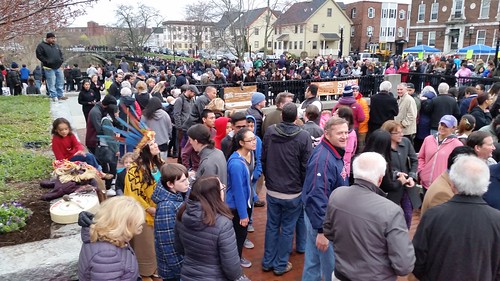
Crowd at Ecumenical Plaza last night, waiting for Lantern launching
Points of Light Lantern Celebration
Last night’s Points of Light Lantern Celebration was a huge success, bringing much-needed vibrancy and attention to Ecumenical Plaza, a community space first envisioned by Pat Mogan’s Model Cities Program of the 1960s. A large brick plaza that spans the Western Canal between Holy Trinity Greek Orthodox Church and St. Patrick’s Church in the Acre, Ecumenical Plaza should be seen as the heart of Lowell, the place where every immigrant group that has come to the city since the Irish of the 1820s has made their home. (For more on this history of Ecumenical Plaza, check out this recent post by James Ostis). Those roots run deep and last night proved that they are still very much alive. Nurturing them with events like the Lantern Celebration will pay great dividends.
So what was the Points of Light Lantern Celebration and how did it come about? The driving force is a three-year old volunteer organization called DIY Lowell or Do-It-Yourself Lowell, which identifies itself as “a community-led initiative to create small-scale projects and events in Lowell. Community members submit, vote on, and implement ideas.” Past projects by DIY Lowell include a Downtown Lowell History Trail, Bus Stop Libraries, and a Pop-up Parklet on Merrimack Street.
Here’s how the DIY website described last night’s Points of Light Floating Lantern Celebration:
A DIY Lowell group is bringing Lowell’s First Annual “Points of Light” Floating Lantern Celebration on April 22, 2017, 5-9 pm, at Ecumenical Plaza!
A spring celebration of unity and renewal that brings together the food, music, and traditions of Lowell’s diverse cultures. The centerpiece of the night is a special ceremony in which participants personalize water lanterns that will be released onto the Western Canal, creating hundreds of floating points of light.
In Japan, participants float paper lanterns in memorial during Tōrō nagashi. In Thailand and Laos, people celebrate Loi Krathong by floating a small boat with a candle. In Cambodia, it is the festival of Bonn Om Teuk. In India, a religious ceremony includes candles floated on the Ganges. Lichterswimmen has occurred in Zurich for over half a century, and floating candles is part of a Slavic holiday, Kupala Night.
This was even a tradition in Lowell, kicking off the Southeast Asian Water Festival for many years. A DIY Lowell group is bringing it back, using lanterns to symbolize the common thread throughout all our cultures.
Although I served as the Master of Ceremonies last night, I was not involved with the planning of the event. I do know that to have an incredible event, you have to have incredible planning, so hopefully the organizers will share with us more details of how this all came about. We all owe them our gratitude for bringing such a wonderful event to the city.
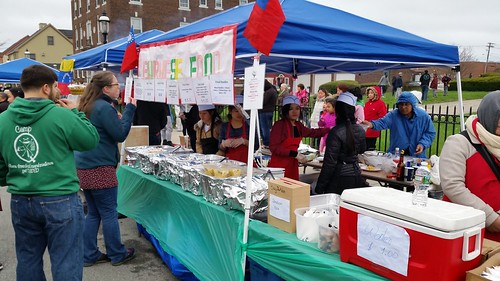
When I arrived at Ecumenical Plaza at 4:15, food booths with Greek, Burmese, Venezuelan, Liberian and Latino foods (plus Gormley’s Restaurant) were already set up and cooking on Suffolk Street. A stage with a professional sound system was on the Lewis Street side of Ecumenical Plaza, facing St. Patrick’s. Other tables for community groups like Coalition for a Better Acre, and for Lowell National Historic Park surrounded the plaza.
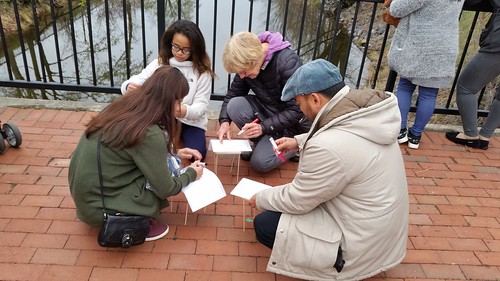
Decorating lanterns
Even before 5 pm, the official start of the event, a line had formed at the “lantern decorating table.” The lanterns consisted of small squares of wood, tiny candles, and folded white paper “sides” for the lantern. Participants were each given one of the white paper lantern sides to decorate with the many markers and crayons that were available. Then the decorated sides were affixed to a wooden base. All were stockpiled near the launch site until dusk.

Lanterns ready for launching into Western Canal
In the meantime, festival-goers were entertained by the St. Patrick’s Church youth group, Viet Vibrations, with their traditional Vietnamese drums; the Girls Inc. Dancers; SayDaNar Burmese Dancers; and the Shane’s Team, No Bullies Zone Kidz dance team. After the lanterns were launched, entertainment was provided by Natalya Kay (Irish folk music) and Sabano and Talento (Venezuelan music). Tours of the interiors of Holy Trinity and St Patrick’s churches were also offered.
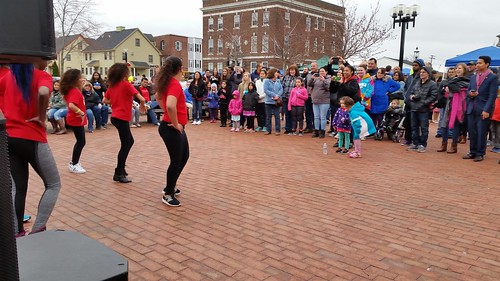
Girls Inc Dancers entertaining the crowd
A short speaking program featured city greetings from Mayor Ed Kennedy (Councilors Corey Belanger, Bill Samaras, Jim Leary and Rodney Elliott, School Committee member Bob Hoey and State Representative Rady Mom were also in attendance); greetings from St. Patrick’s Church by Fr. Bill O’Donnell, remarks from Theresa Farrah of Clark Insurance (major event sponsor) a poem from local poet Augustus Clayton, remarks by Dave Ouellette of ACTION, Chris Hayes and Aurora Erickson of DIY Lowell, and Joan Chun of Khmer New Year committee. Then there was a Khmer blessing by Kennis Mor and a Taino prayer by Patricia Smilez Dones.

Hundreds lined the banks of the canal waiting for lanterns to float by
With that, the launching of the lanterns began just as darkness was falling. Hundreds of people lined the banks of the Western Canal and its bridges as bright lights illuminated the facades of Holy Trinity and St Patrick’s churches. Someone estimated the crowd to be close to one thousand – I know that materials for 800 lanterns were consumed – and it was a diverse group representing every ethnicity in the city. Pat Mogan would have been proud.
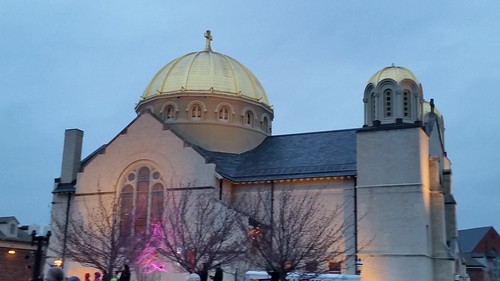
Holy Trinity Greek Orthodox Church

St. Patrick’s Church
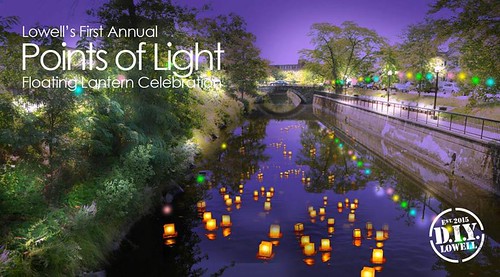
Parking
On Thursday this past week, I received via US mail an article torn from the April 8, 2017 edition of The Economist. The article, Aparkalypse now, contends that our policy towards urban parking, both in the US and abroad, is highly irrational and highly destructive. The article continued that unless cities radically change their policies towards parking, all other efforts undertaken to make cities more appealing are just window dressing. Carving out more space for parking just invites more people to drive while using up space that could be used more productively. And parking garages are expensive to build and maintain.
The very next day, the Lowell Sun had a front page story on parking in Lowell. “Murphy: More parking a priority in Lowell” featured City Manager Kevin Murphy explaining that “a severe parking shortage [in Lowell] could stymie future development.” Design work is already underway on a 900-space garage in the Hamilton Canal District that would be located near the Market Mills complex, closer to Market Street. The cost of that garage has already been budgeted.
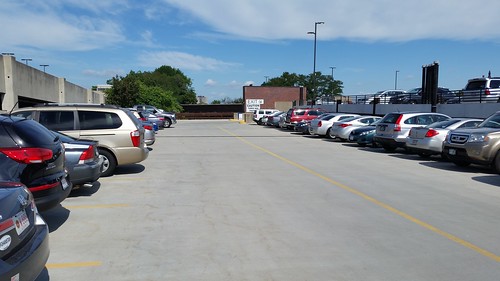
But Murphy also said that the Hamilton Garage will be filled the day it opens, and that the city will require an additional 300 spaces it has promised for the Judicial Center. The city envisions building another garage closer to the Middlesex Street end of the Hamilton Canal District, adjacent to the Judicial Center. An additional garage is also being considered for the Davidson Street surface parking lot which is off East Merrimack Street, across from the Lowell Memorial Auditorium.
The City Manager did point out that with the cost of a new Lowell High School expected to raise property taxes by as much as 7.5 percent, finding the money to pay for these additional garages (and for any other capital projects) will be difficult.
So what’s the answer? Do we need less parking, or more parking? The only thing I know for certain is that everyone has a strongly-held opinion on this topic, but few of those opinions are in consensus. I tend to come down on the less parking is better side, but it’s very complicated. Here’s how I look at it:
Downtown Lowell has an identity crisis. What does downtown want to be? Is it a central business district? Is it a cultural mecca? Is it a residential neighborhood? Right now, it’s a little bit of all three, but not enough of any to succeed. The days of big downtown retail establishments and office buildings filled with doctors, lawyers, and other white collar workers are long gone and a strategy that pursues such uses is futile. Better to go all-in on residences. Find ways to assist building owners with no elevators and vacant upper floors to convert those spaces to fully-accessible residences. We’re in the midst of a housing shortage, both in Lowell and throughout the region. If there’s a demand for more housing, why not create more of it?
I believe a recent study – the Urban Institute, perhaps? – found that Lowell needed to at least double the number of people living downtown to be able to reliably support retail establishments. For retailers, more downtown residents would require an operational inversion, giving priority to night and weekend hours, which would be when people were around, and less focus on traditional weekday hours that cater to a workforce that is no longer present.
When City Manager Murphy was hired three years ago, he frequently spoke of Lowell becoming a “college town.” I fully embrace that vision. With both UMass Lowell and Middlesex Community College located here, Lowell is perfectly positioned to leverage the economic benefits that spin-off from higher education, both innovative new industries and traditional retail that thrives in a true college town setting.
But with the city council’s chronic negativity towards UMass Lowell, the term “college town” seems to have been purged from our planning vocabulary. That’s an unfortunate and destructive detour. The college town concept is completely compatible with a greater emphasis on more residences in downtown. It is also consistent with supporting the type of retail trade that is most likely to succeed in 21st century America. Think about it: Suburban shopping malls killed major downtown retail, but now Amazon is killing suburban shopping malls. I’m convinced that there is a growing niche in our retail food chain for small, unique establishments that add an “experiential” element to shopping. And the businesses I describe don’t need to be high-priced boutiques – smart entrepreneurs who know their customers can provide affordable products and services and still keep their doors open. So I don’t think downtown retail is dead. I just think it has to be smart. But it also needs customers.
Just add people – Go to downtown Lowell on a non-festival weekend day. It’s a lonely place. Businesses won’t open because there are no customers. People won’t come downtown because none of the businesses are open. The tragic irony is that there is much to do and see in downtown. There are canals, rivers, public art, restored buildings – you just have to walk around with your eyes open to find it. That was the whole purpose of Lowell Walks, and that’s a big reason why we have drawn an average of 100 people to downtown on each Saturday morning walk during the past two summers. But people shouldn’t need an organized walk or a unique festival to come to downtown Lowell (although both are great reasons to go there). Just go and walk around. If enough people do that, good things will start happening.
So where will all these people park, to bring us back to our point of departure? Someone on Facebook said that Lowell’s dilemma is that it’s too big to provide convenient downtown parking, but too small to support mass transit that would significantly reduce the demand for parking. There’s some truth to that observation, but it’s not an insolvable problem.
To paraphrase the first President Bush, we need more of “that vision thing.” As a city, we seem to be in a reactionary mode, spending lots of time putting out the fires the pop up, and not enough time creating a shared vision of what kind of place we want to be and how we get there.
As for parking, the first step should be to raise the price for it significantly, especially for curbside parking. There’s a saying that Americans like everything about socialism but the label. That definitely applies to parking. Many act as if free, readily available parking is an inalienable right. It’s not. We live in a capitalist system. If there is more demand for curbside parking, raise the price charged for it. It’s all about supply and demand. If you make it easy and cheap for people to drive cars, they will always drive cars. Raise the price, and other transportation options will become more attractive. Besides, we’ll need all that additional revenue to pay for the new parking garages we still need.
Council Meeting
After a week off due to school vacation, the council resumes its regular schedule this Tuesday night. My coverage of that meeting will be delayed for a day or two, because I’ll be at Lowell National Park Visitor Center during the meeting for the Browsing Through Birke’s program which features a documentary film about the iconic Lowell clothing store followed by a panel discussion about the experience of refugees forced to flee their native lands by violence and hatred, something experienced by Nathan and Sally Birke, who fled their native Poland to escape the Holocaust.
Regarding the council meeting, there are 15 motions on the agenda. Here they are, courtesy of the City Clerk’s office:
- Leahy – Req. City Mgr. have DPW inspect Butman Road from Hovey Street to Rogers Street for the purpose of clean-up of the road and sidewalks; including trimming back of any trees that may need it.
- Leahy – Req. City Mgr. provide City Council with a street paving plan for major roads throughout the City, including the downtown area.
- Leahy – Req. City Mgr. provide update regarding construction at the Broadway Street Bridge.
- Mercier – Req. City Mgr. work with the Vurgaropulos family to erect appropriate signage on the Vurgaropulos Bridge.
- Milinazzo – Req. City Mgr. report on the Business Tax now being assessed to the artists at Western Avenue Studios.
- Samaras – Req. City Mgr. have DPD prepare a plan that would create a student zone (a university district that is student friendly).
- Belanger – Req. City Mgr. have proper department evaluate speeding on Draper St. and Arbor Rd. and take any appropriate action to address issue.
- Belanger – Req. City Mgr. provide a report from the Cultural Affairs Special Events (CASE) outlining upcoming special events in 2017.
- Leary – Req. City Mgr. invite the Markley Group and Verizon to the Technology & Utilities SC in order to discuss commercial and residential high speed internet connectivity options.
- Leary – Req. City Mgr. report on the status regarding the neglected home located at 151 Wedge Street.
- Leary – Req. City Mgr. review the feasibility of creating an application (“APP”) in order to determine the availability of parking spaces within the City owned parking garages and public parking on streets.
- Rourke – Req. City Mgr. have Inspectional Services provide report updating the repairs being done on properties at 138 and 200 Cross Street.
- Rourke – Req. City Mgr. review procedures of the Board of Parks for implementation and/or waiver of fees for use of fields for local groups.
- Rourke – Req. City Mgr. update Council regarding DPW needle pick-up program.
- Kennedy – Req. City Mgr. review possible installation of a sidewalk on Stedman Street in the vicinity of 22 Olde Canal Drive.

Wednesday Night Book Event at UMass Lowell
Don’t forget next Wednesday’s Local Author Marketplace at UMass Lowell’s O’Leary Library from 7 to 9 pm. I’ll be there with my three books for sale (Lowell Municipal Elections: 1965 to 2015; Legendary Locals of Lowell; Lowell: Images of Modern America) along with many other Lowell authors. This is a great opportunity to meet and speak with local authors, and to pick up a book or two. The event is free (although the books are not). Parking will be available in the UML Wilder Street lot, across from the library.
I was born, raised in Lowell – my mother and aunts worked the mills. Although I do not live in Lowell, it us my pleasure to be involved with the Merrimack Repatory Theatre. I would like to see Lowell enhance as a historic/college/artsy (“hiopy”) community such as Northampton et al. It would bring small business and therefore busy weekends.
I was born, raised in Lowell. My mother worked in the mill. I do not live in Lowell but very involved in the creative Merrimack Repatory Theatre. I would like to see Lowell embrace it’s history and embrace its college-artsy style, such as in Northhampton. There would be chic small businesses, cafes and visits on all weekends.
I rented the documentary Citizen Jane:Battle for the City on-demand last night. It told the story of Jane Jacobs’ life as a writer turned activist in observing what makes a successful city and stopping top-down city planning like urban renewal and urban highways from destroying cities.
The takeaway for me was that you need to look at what’s working at the street level and then make incremental improvements from there. I think we can all agree that the corner of Middle and Palmer is working. So how can we improve that area? Convincing Enterprise Bank to rent out the ground floor space they own on both corners to retail or restaurants makes the most sense. Back office banking should be on the upper floors and out of sight. The question is would Enterprise Bank be willing to admit their mistake and move so quickly after rehabbing the space?
I don’t agree with trying to be a just a college town or just a business district or just a residential neighborhood. Jacobs says the aim for cities should be a diversity of people, doing a diversity of things, and all hours of the day. More people in the public realm makes streets safe and creates opportunities for economic vitality. Buildings built right up to the sidewalk, a mix of old and new buildings, short blocks, narrow streets, wide sidewalks all create places where businesses can thrive and people want to be.
At no time does she say cities need parking garages, free parking, minimum parking requirements, gigantic courthouses, or wide and fast streets like Dutton St, Gorham, Thorndike, Nesmith, and VFH Highway to be successful. Yet that is our playbook!!! Those streets are the noose around downtown’s neck. And we scratch our heads and wonder why businesses fail and congestion sucks in this city.
Lowell’s small size is our greatest strength. We don’t need light rail or mass transit to connect the pre-WWII neighborhoods back to downtown. A low cost protected bike network, sidewalk improvements, and street narrowings could breath life into Back Central, the Acre, Lower Belvidere, or Lower Highlands. Why not choose one neighborhood to try this and see what happens? If it works move on to the next neighborhood. If it doesn’t at least we tried. Sure beats the status quo.
As for pricing on street-parking the goal it to always have 15% of the on-street spots available on each block. This is done through dynamic pricing. You analyze the data and adjust prices accordingly. So prices would go up on Middle St and go down where demand is low.
Some will complain where prices go up so offering free short term parking in the garages is key. Many cities offer 1.5-2 hours free garage parking. It creates a sense of fairness and will reduce the congestion caused by circling Merrimack, Market, and Middle for a good spot.
Long term garage parking should be market rate. Since our garages are filling up during the day prices need to go up to create vacancies yet go down at night if garages are half full. Charging a market rate for long term parking should reduce congestion since alternative transportation options or commuter carpooling will make more sense. Residents who have cars but don’t use them much might get rid of them and utilize Zipcar, creating space in the garages.
It’s foolish people talk of building more garages before exhausting all potential on-street spots first. There are scores of opportunities for metered parking on Dutton St, Bridge St(downtown), Central St, Gorham St, Church St, and Arcand Dr. It’s no coincidence these streets have chronically empty storefronts.
More garages in the Hamilton Canal District will cause more congestion downtown and make the HCD less than great. People seem to ignore that on-street metered parking will be in the HCD and don’t account for it.
But what would an alternative plan for the HCD look like? Ditch the master developer, split the blocks into small lots, and sell them to local developers. See https://www.strongtowns.org/journal/2017/4/18/cities-purchase-big-lots-sell-small-scale-developers
“If we want to build more great places, we need to reproduce the mechanisms that were in place that enabled our most beloved places to be built the way that they are.”- Andrew Price
You can’t make it easy to drive through downtown on Church, Central, Bridge, Gorham, Thorndike, Dutton, and Arcand Dr and then complain when businesses fail downtown. You can’t build more garages and expect less congestion. You can’t allow surface parking lots downtown then expect people to like walking around in that environment. Imagine if every other space in the mall were empty, you wouldn’t go. That’s what parking lots do to main streets.
Parking lots on Central, Middle, East Merrimack St, Merrimack, Market, John, Lee, Paige, Worthen, Jackson, Middlesex, and Hurd St could be developed with 3+ story buildings. But this can only happen if minimum parking requirements are eliminated downtown.
The city should then mandate ground floor retail or restaurant space with housing or office space above for maximum benefit. Or at least exempt parking requirements for projects that meet the criteria. That’s how you create a critical mass of people without worsening congestion or needing more garages.
Kudos to Teddy Panos for building on his parking lot. I don’t agree with him much but he knows we need smart parking policy as well. Too bad Dave Daly didn’t swap land with Gervais and hide the parking lot fronting his East Merrimack St development. Would’ve been a better project.
AT&T in Dallas has agreed to keep its headquarters downtown but only if the city makes improvements for pedestrians, narrows main streets, and reverts one-way streets to two-ways. Walkability is not a partisan issue that only liberals should support but an important part of a development pattern that fosters economic vitality AND social capital.
You can read about it here: https://www.strongtowns.org/journal/2017/4/24/att-pushes-dallas-toward-more-walkable-productive-streets
Not sure Lowell has any companies or institutions that would throw its weight around to increase walkability. Maybe Enterprise Bank or UML? Not Lowell Five- they gave up on downtown.
How many more companies have to move to other urban cities before Lowell leaders stops destroying our beautiful downtown with garages and wide streets and embrace a more economically productive downtown?